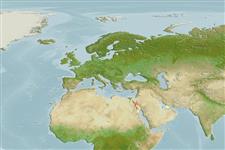>
Gobiiformes (Gobies) >
Gobiidae (Gobies) > Gobiinae
Etymology: Gobiodon: Latin, gobius = gudgeon + Greek, odous = teeth (Ref. 45335); ater: Named for its uniformly black life colouration, including the eye; from the Latin words 'ater' for black.
Environment: milieu / climate zone / depth range / distribution range
Écologie
marin récifal. Tropical
Indo-West Pacific, Red Sea.
Taille / Poids / Âge
Maturity: Lm ? range ? - ? cm
Max length : 2.7 cm SL mâle / non sexé; (Ref. 94082)
Description synthétique
Clés d'identification | Morphologie | Morphométrie
Épines dorsales (Total) : 7; Rayons mous dorsaux (Total) : 10; Épines anales: 1; Rayons mous anaux: 8. This species is distinguished by the following characters: D VI+I,10; A I,8; head and body are naked; presence of a deep curved groove on isthmus; body and caudal peduncle slender (depth 37-41.2% and 13.8-14.7% SL, respectively); juveniles with rounded head, large adults slightly hump-headed; colour in juveniles and adults uniformly black, including iris; very small species (< 2.8 cm SL); females of breeding pairs usually significantly larger than males, recorded smallest highly gravid female is 1.85 cm SL (Ref. 94082).
Facultative air-breathing in the genus (Ref. 126274); This species is found in shallow water regions such as protected reef flats and reef crests. It is highly specialized and prefers fine-branched corals such as Acropora selago and small tabulate colonies of Acropora hyacinthus. Seldom occurs in other Acropora species, such as A. acuminata, A. samoensis, A. eurystoma and A. valida. Due to its black colouration it is sometimes difficult to detect within the dark interstices of narrow-branched Acropora colonies (Ref. 94082).
Life cycle and mating behavior
Maturité | Reproduction | Frai | Œufs | Fécondité | Larves
Herler, J., S.V. Bogorodsky and T. Suzuki, 2013. Four new species of coral gobies (Teleostei: Gobiidae: Gobiodon), with comments on their relationships within the genus. Zootaxa 3709(4):301-329. (Ref. 94082)
Statut dans la liste rouge de l'IUCN (Ref. 130435: Version 2024-1)
Menace pour l'homme
Harmless
Utilisations par l'homme
Outils
Articles particuliers
Télécharger en XML
Sources Internet
Estimates based on models
Preferred temperature (Ref.
123201): 24.9 - 27.2, mean 26.7 °C (based on 18 cells).
Phylogenetic diversity index (Ref.
82804): PD
50 = 0.5000 [Uniqueness, from 0.5 = low to 2.0 = high].
Bayesian length-weight: a=0.01995 (0.00906 - 0.04395), b=3.01 (2.83 - 3.19), in cm total length, based on all LWR estimates for this body shape (Ref.
93245).
Niveau trophique (Ref.
69278): 3.2 ±0.4 se; based on size and trophs of closest relatives
Résilience (Ref.
120179): Haut, temps minimum de doublement de population inférieur à 15 mois (Preliminary K or Fecundity.).
Fishing Vulnerability (Ref.
59153): Low vulnerability (10 of 100).
